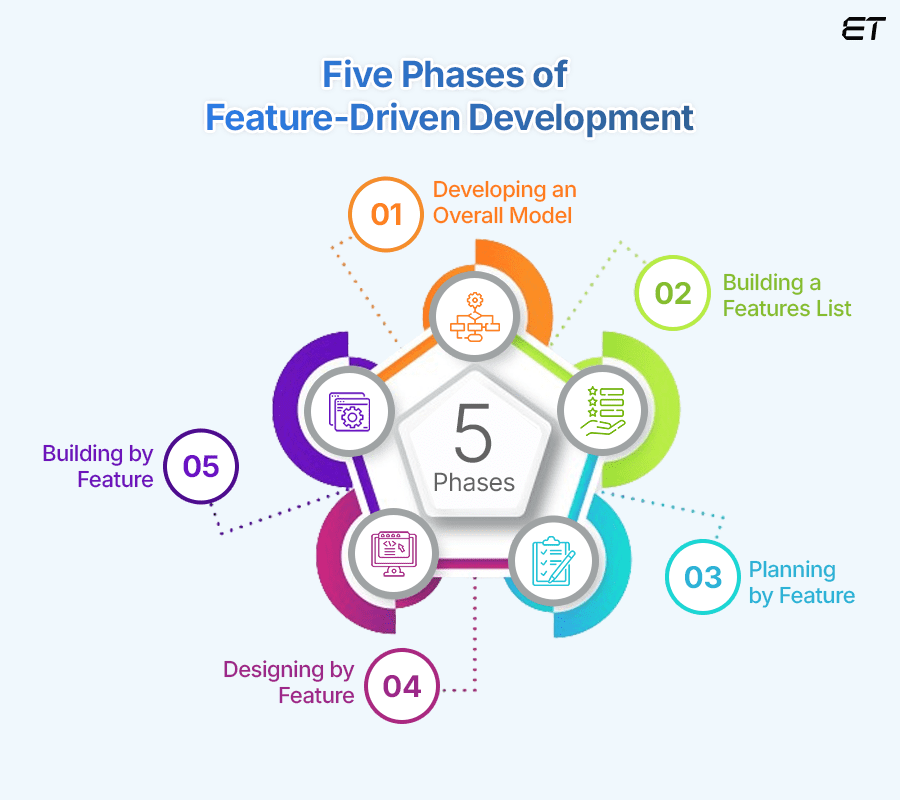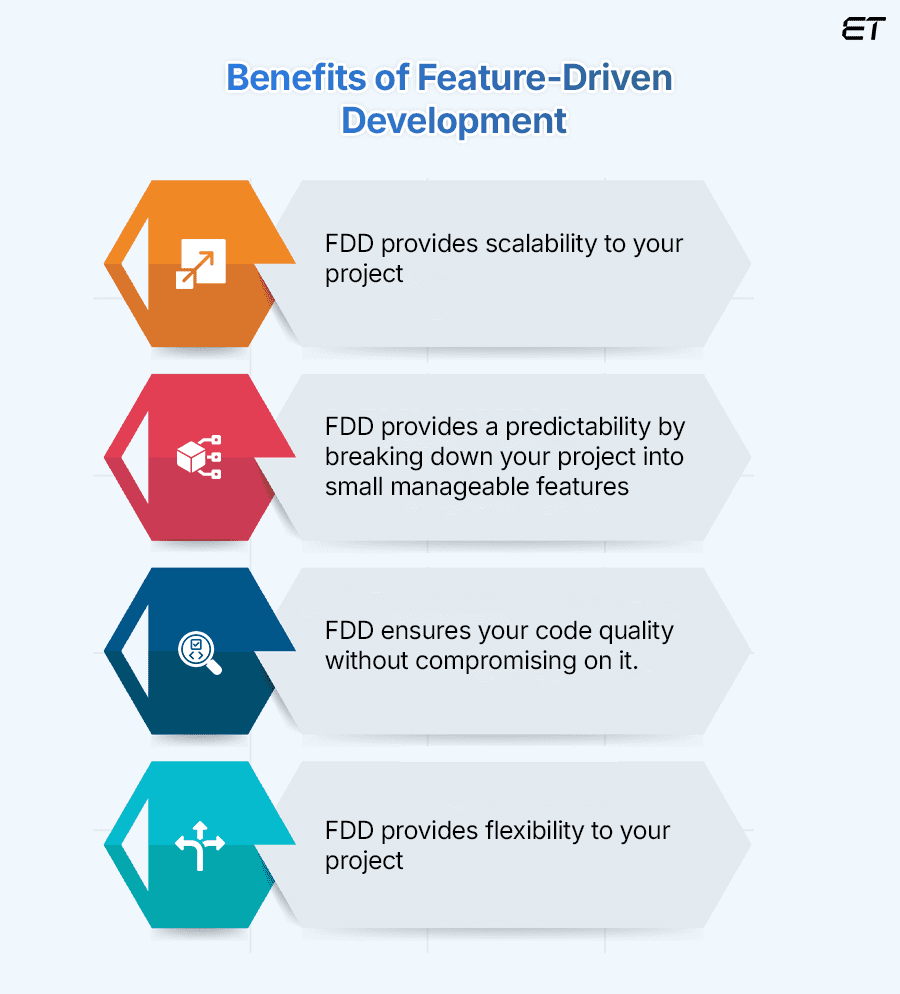
Feature-Driven Development (FDD) and Agile Modeling- Detailed Guide
Imagine launching a new software project with a promise of innovation and efficiency, only to find it drifting off course because of either unclear priorities or an overwhelming scope. It’s like trying to build a house without any planning or blueprint—frustrating and prone to costly mistakes. Isn’t it?
Therefore, you always plan the structure first and then actually build the house. Similarly, feature-driven development in software engineering is your architectural guide for developing software, ensuring that every step of your project is well-planned, organized, and aligned with your business goals.
In today’s cutthroat market, where speed and quality are non-negotiable, FDD offers a structured yet agile approach that breaks down complex projects into simpler, manageable, and customer-focused features. It’s not just about writing code; it’s about creating a cohesive strategy that drives your software development forward, one feature at a time. This incremental and adaptive process allows for rapid feedback and adjustments, ensuring high-quality outputs while adapting features based on time and complexity constraints, a concept known as feature finally.
This blog will explain the essentials of Feature-Driven Development and show how this methodology can transform your project.
What is Feature-Driven Development?
Feature-Driven Development (FDD) is an Agile methodology designed to deliver tangible results in a structured manner. Unlike other Agile frameworks that focus on flexibility and iteration, FDD emphasizes building software by breaking down the development process into features.
These features are small, client-valued functions designed, developed, and tested within a short timeframe. The project manager oversees the collaborative and iterative design process within development teams, helping with feature prioritization, nominating class owners, and assigning tasks to ensure effective workflow. The result? a reliable and predictable method of delivering high-quality software, particularly suited for large and complex systems, where each feature finally ensures incremental and adaptive development.
Feature-Driven Development example includes development of specific and structured features that cater to the industry like e-commerce website, banking application, customer-relationship management system, healthcare management, travel booking platform, etc.
Want to get more insights on software testing and quality assurance of how it’s done?
Key Principles of Feature-Driven Development
Feature-Driven Development (FDD) is guided by several key principles that enable development teams to deliver high-quality software quickly and efficiently. These principles include:
- Client-Valued Functionality: At the heart of feature-driven development is the focus on delivering features that provide tangible value to the client. This means that development teams prioritize creating working software that meets the client’s specific needs, ensuring that each feature developed contributes directly to the overall business objectives.
- Domain Object Modeling: FDD places a strong emphasis on domain object modeling, which involves creating a conceptual model of the business domain. This process helps development teams gain a deep understanding of the client’s requirements and the relationships between different entities within the system. By doing so, teams can develop software that is not only functional but also aligned with the client’s business processes.
- Feature Teams: In FDD, feature teams are small, cross-functional groups responsible for developing specific features. These teams are composed of members with diverse skills, enabling them to work collaboratively and efficiently. Their use ensures that development is focused, organized, and capable of delivering features quickly.
- Iterative and Incremental Development: FDD follows an iterative and incremental approach to software development. This means that development teams deliver working software in small, manageable increments. By doing so, they can respond swiftly to changing requirements and continuously improve the software, ensuring high quality and client satisfaction. This approach allows teams to adapt features based on time and complexity constraints, ensuring each feature finally meets the desired standards.
- Configuration Management: Effective configuration management is crucial in FDD. It involves managing changes to the software development project, ensuring that all modifications are properly documented and controlled. This helps maintain the stability of the project and ensures that the development process remains organized and predictable.
By adhering to these principles, feature-driven development offers a structured yet flexible approach to software development, enabling teams to deliver high-quality, client-valued features efficiently.
The Five Phases of Feature-Driven Development

Feature-driven development is structured around five key phases, each contributing to the systematic development of software from initial planning to final delivery. Each phase ensures that your project progresses in a controlled, predictable manner while also allowing for flexibility and adaptation as needed. How? Feature finally, this approach allows for rapid feedback and adjustments, ensuring high-quality outputs while adapting features based on time and complexity constraints.
Let’s understand the five phases one by one in detail:
1. Developing an Overall Model
The first phase of FDD is about laying the groundwork and a strong foundation. Before any code is written, the development team works closely with stakeholders to create an overall model of the system. This involves gathering requirements, understanding the business domain, and creating a high-level Domain Object Model (DOM). The goal here is to gain a comprehensive understanding of the project’s scope and the relationships between different entities within the system.
This phase is crucial because it sets the stage for all subsequent development activities. By developing a clear and shared vision of the system’s architecture, the team can avoid misunderstandings and ensure everyone is on the same page. The entire model serves as a blueprint that guides the development process, ensuring the project stays aligned with the business objectives. Additionally, adapting features based on rapid feedback and complexity constraints ensures high-quality outputs, allowing the team to focus on each feature finally.
2. Building a Features List
Once the overall model is in place, the next step is to break down the system into smaller, manageable pieces–these are the “features.” A feature in FDD is a small, client-valued function that delivers specific business value. This phase involves identifying all the features that need to be developed, organizing them into a hierarchical structure, and prioritizing them based on business needs.
The features list acts as a detailed to-do list for the development team. It ensures that the project is broken down into manageable tasks, making it easier to track progress and manage the workload. Notably, the features are defined to be completed within a short time frame, usually two weeks or less, which keeps the project moving forward steadily. Adapting each feature finally based on rapid feedback and complexity ensures high-quality outputs.
3. Planning by Feature
Planning by feature is where FDD starts to explore the tiniest details of project management. In this phase, the team creates a detailed plan for developing each feature. This includes assigning tasks to individual team members, estimating the time required to complete each feature, and identifying any dependencies or risks.
This phase is critical for controlling the project’s timeline and budget. By planning each feature in detail, your team can ensure that resources are allocated efficiently and potential issues are identified and addressed early on. This structured planning process helps to minimize surprises and keeps the project on track.
4. Designing by Feature
In the designing by feature phase, each feature is designed in detail before its implementation. This phase involves creating detailed design documents, conducting design reviews, and ensuring that the feature fits into the overall system architecture. The design phase is highly collaborative, often involving input from multiple team members, including developers, architects, and business analysts.
Designing by feature ensures that each part of the system is well thought out before coding begins. This reduces the risk of rework and helps ensure that the final product meets the client’s requirements. By focusing on one feature at a time, your team can maintain a high level of quality and attention to detail, which is crucial for the project’s success. Adapting features based on feedback and complexity allows for rapid adjustments, ensuring high-quality outputs while managing time and constraints, a process known as feature finally.
5. Building by Feature
The final phase of FDD is where the actual development takes place. In this phase, the team writes the code for each feature, integrates it into the system, and conducts thorough testing to ensure it works as expected. This phase is iterative, with features being developed, tested, and refined in short cycles.
Building by feature is where the project comes to life. The iterative nature of this phase allows your team to make continuous improvements and ensures that the project stays aligned with your business goals. By focusing on one feature at a time, the team can deliver a steady stream of working software, which stakeholders can review and validate on an ongoing basis.
The Role of Feature Teams in Software Development Projects
Feature teams play a critical role in software development projects that use Feature-Driven Development (FDD). A feature team is a small, cross-functional team responsible for developing specific features. The feature team is tasked with several key responsibilities:
- Developing Features: The primary responsibility of a feature team is to develop the features assigned to them. This involves the entire development lifecycle, from designing and coding to testing and delivering the features. By focusing on specific features, the team can ensure that each one is developed to meet the client’s needs and integrates seamlessly into the overall system. By adapting each feature finally based on feedback and complexity, the team ensures high-quality outputs.
- Collaborating with Other Teams: Effective collaboration is essential in FDD. Feature teams work closely with other teams, such as project management and quality assurance, to ensure that the features are developed correctly and meet the client’s requirements. This collaboration helps to identify and address any issues early in the development process, ensuring a smoother workflow.
- Managing Small Development Teams: Feature teams are typically composed of 2-5 people, making them small and manageable. The feature team is responsible for assigning tasks, tracking progress, and ensuring that the team works collaboratively. This close-knit structure allows for efficient communication and quick decision-making, which is crucial for the timely delivery of features.
- Feature Design: Designing features is a critical part of the feature team’s responsibilities. This involves creating detailed design documents and ensuring that the design aligns with the client’s needs and the overall system architecture. By focusing on thorough design, the team can reduce the risk of rework and ensure that the final product meets the client’s expectations.
- Delivering Working Software: Ultimately, the feature team is responsible for delivering working software that meets the client’s needs. This involves rigorous testing, fixing defects, and ensuring that the software is stable and functional. By delivering features incrementally, the team can provide the client with regular updates and gather feedback, ensuring that the project stays aligned with business goals.
Overall, FT are integral to the success of software development projects using FDD. They ensure that features are developed efficiently, collaborate effectively with other teams, manage small development teams, design features meticulously, and deliver high-quality, working software.
Advantages of Feature-Driven Development

Now that you know the meaning and the five stages of FDD, let’s understand its benefits for your projects, especially large and complex ones.
Scroll below to read:
- Scalability: FDD can easily handle large projects, making it ideal for you to develop extensive systems with multiple features.
- Predictability: By breaking down the project into small manageable features, Feature-Driven Development provides a predictable development process, helping your teams stay on schedule and within budget.
- Quality Assurance: The emphasis on class and method ownership ensures that your code quality is maintained, reducing the likelihood of defects in your software development and providing a more reliable product.
- Flexibility: While feature-driven development provides structure to your software development, it also allows flexibility in responding to changes. This makes it suitable for your project to evolve over time as per the latest requirements.
Disadvantages of Feature-Driven Development and Considerations
There are always two sides to everything—a good and a bad. While feature-driven development offers many benefits, it’s essential to be aware of its potential challenges in your software development.
Wondering what those are? Let’s get to it!
- Initial Complexity: The upfront effort required to develop your software’s overall model and build its feature list can be time-consuming, mainly if your team is new to FDD.
- Feature Definition: Defining features that are both meaningful to your client and manageable within a short development cycle requires your team to plan carefully and communicate clearly.
- Collaboration: Feature-driven development relies heavily on cross-functional collaboration. Therefore, it can be challenging if you have siloed teams or rigid hierarchies.
FDD vs Other Agile Methodologies
When evaluating feature-driven development (FDD) vs scrum and other Agile methodologies like Kanban, and Extreme Programming (XP), you need to recognize that while all these approaches share the Agile philosophy of iterative development and flexibility, they each cater to different types of projects and team dynamics.
Let’s explore the differences between Feature-Driven Development vs scrum and other Agile methodologies other Agile methodologies. Scroll below:
FDD vs Scrum vs Kanban vs Extreme Programming (XP)
| Aspect | Feature-Driven Development | Scrum | Kanban | Extreme Programming (XP) |
| Approach | FDD is structured and has feature-centric development. It emphasizes adapting features based on feedback and complexity, ensuring high-quality outputs by focusing on each feature finally. | Scrum is iterative and has sprint-based development | Kanban is visual and has flow-based management of tasks | XP is iterative and customer-centric with a focus on code quality |
| Project Suitability | Supports large, complex projects with well-defined requirements | Supports projects needing flexibility and adaptability | Supports ongoing, operational work or projects needing continuous delivery | Supports projects requiring frequent changes and continuous customer feedback |
| Development Phases | It has five defined phases:
|
It has sprints with defined goals, daily stand-ups, and sprint reviews | It has no defined phases; continuous flow of work is managed on a Kanban board | Iterations are done with continuous feedback, test-driven development, pair programming |
| Time Dynamics | Teams have defined roles with specific responsibilities | It has cross-functional teams with shared responsibilities | Teams are self-managing, have flexible roles, and focus on continuous flow | Team members are highly collaborative and have shared responsibilities |
| Focus | Building client-valued features with predictability and quality | Rapid adaptation to change, continuous improvement | Improving workflow efficiency, reducing bottlenecks | Delivering high-quality code with continuous customer involvement |
| Planning and Design | Heavy emphasis on upfront planning and design | Planning and design occur within each sprint and are flexible to change | Planning occurs as needed, with a focus on managing flow rather than planning phases | Minimal upfront planning and design evolves through iterations |
| Flexibility | Moderate flexibility with structured process | High flexibility with adaptability to evolving requirements | High flexibility with adaptability to changing priorities and workloads | High flexibility; changes are embraced even late in the development process |
| Best Use Case | Ideal for enterprise-level projects requiring clear structure and predictability | Ideal for projects with evolving scope and a need for regular client feedback | Ideal for projects or teams that need to manage ongoing tasks with varying priorities, such as support or maintenance work | Ideal for projects where requirements change frequently and where code quality and customer satisfaction are paramount |
Looking for a partner that can guide you through your complex projects? Don’t worry, we’re here!
How Do You Decide if FDD is Right for Your Business?

Now that you’re aware of what feature-driven development is and the differences between FDD and other Agile methodologies, a question might arise in your mind—How do you decide if FDD is right for your business? Well, the business nature plays a crucial role in whether or not you should implement FDD in your business. It involves considering several key factors stated below:
1. Evaluate the complexity and scale of your project. If you’re dealing with an extensive, intricate system where maintaining structure and predictability is crucial, FDD’s methodical approach can significantly benefit your project. Feature-driven development is suited for environments where the requirements are relatively stable, and the goal is to deliver high-quality features that align closely with your business objectives.
2. Secondly, think about your team’s composition and experience. FDD works best with teams that have a clear understanding of their roles and responsibilities. FDD could be an excellent choice if your team thrives on structure and enjoys working within a clearly defined process. On the other hand, if your project requires frequent changes or rapid iterations, and your team is more accustomed to flexible, adaptive methodologies, you might want to consider other Agile frameworks like Scrum or Kanban.
3. Additionally, consider your business’s strategic goals. Feature-driven development’s focus on delivering client-valued features makes it ideal for projects where customer satisfaction and business value are top priorities. If your business prioritizes delivering a polished, feature-rich product with minimal risk of scope creep, FDD can help keep your development efforts aligned with those goals.
Wrapping Up!
As we wrap up, choosing the right development methodology can differentiate between a project that gets done and one that truly excels. Feature-driven development offers a structured yet flexible approach that’s particularly well-suited for complex, large-scale projects. By focusing on delivering client-valued features, FDD ensures that every step of the development process is aligned with your business goals, resulting in a product that meets your expectations both in quality and functionality.
If you’re also looking to implement Feature-Driven Development for your software but don’t know where to start, don’t worry. We’ve got you covered! Consult our expert today and learn more about how you can smoothly implement FDD in the development process for your project.
Frequently Asked Questions
1. What types of projects are not well-suited for Feature-Driven Development (FDD)?
FDD may not be ideal for projects that require high levels of flexibility or frequent changes in scope. It is also less suited for small-scale projects where the overhead of its structured processes may outweigh the benefits.
2. How does FDD handle changes in project requirements?
While FDD is more structured, it still allows for flexibility through its iterative approach. However, significant changes in project requirements might require re-evaluating the feature list and adjusting the overall plan, which can be more time-consuming compared to other Agile methodologies like Scrum.
3. Can FDD be integrated with other Agile methodologies?
Yes, FDD can be integrated with other Agile methodologies like Scrum or Kanban. For example, you might use FDD’s feature-centric approach for planning and combine it with Scrum’s sprint cycles for execution. This offers a balanced approach to project management.
4. What are the common tools used to implement FDD in a software development project?
Common tools for implementing FDD include project management software like JIRA, version control systems like Git, and collaboration tools like Confluence. These tools help manage features, track progress, and facilitate communication within the team.
5. Is FDD suitable for small projects or startups?
FDD is generally better suited for large, complex projects with well-defined requirements. For smaller projects or startups that require rapid iterations and flexibility, methodologies like Scrum or Kanban may be more appropriate.
6. What is the difference between Scrum and Feature-Driven Development?
Scrum is an Agile framework focused on delivering work in time-boxed sprints with regular feedback. Whereas, Feature-Driven Development (FDD) is more focused on delivering specific, client-valued features in a systematic way. Scrum emphasizes collaboration and adaptability, while FDD emphasizes planning and structured development.
7. What is the advantage of Feature-Driven Development?
The main advantage of FDD is its clear structure and focus on delivering specific features quickly. It improves team productivity, ensures consistent progress, and provides regular, visible results to stakeholders.
8. What are the disadvantages of Feature-Driven Development?
The disadvantage of FDD is that it can be rigid and less flexible in accommodating changes, especially in dynamic environments. Also, it requires experienced teams and may not suit smaller projects or those with rapidly changing requirements.





